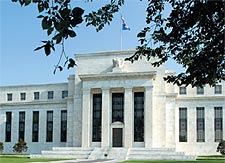|
After approving a cut in its emergency-lending rate to financial institutions to 3.25 per cent from 3.50 per cent last weekend, the US Federal Reserve yesterday announced its largest cut in the short-term interest rates in 15 years. The Fed has lowered its federal funds rate, which is the rate that it charges banks for overnight loans, by three-quarters of a percentage point, to 2.25 per cent. Additional rate cuts can be expected in the months ahead, if needed.  This is the Fed's sixth cut in six months since 18 September 2007 when it announced its first rate cut under the chairmanship of Ben Bernanke - from 5.25 per cent to 4.75 per cent - in a bid to reduce borrowing costs. This is the Fed's sixth cut in six months since 18 September 2007 when it announced its first rate cut under the chairmanship of Ben Bernanke - from 5.25 per cent to 4.75 per cent - in a bid to reduce borrowing costs.
The latest cut is seen as a part of a series of measures taken by the US central bank in its attempt to stabilise the highly volatile financial markets. Though the three-quarter point cut is one of the biggest one-day rate cuts by the Fed in over a decade, investors were betting on a full percentage point roll back, in the face of evidence that a recession in the US economy has begun, and because of the deepening crisis on Wall Street, which saw Bear Stearns bought over by JP Morgan Chase for a fraction of its erstwhile value (See: JPMorgan Chase acquires Bear Stearns for $2 per share). However, some signs of a split among policy makers can be seen, with some members of the Fed's policy-making committee being in favour of an even smaller rate cut, and the policy group collectively expressing concerns about inflation, which can be a reason to veto any future rate cuts. In a statement, the US central bank said that inflation has been elevated, and with some indicators of inflation expectations have raised, it will be necessary to continue to monitor developments carefully. While the three-quarters of a point cut can be seen as a middle path to a compromise with those who wanted a lower cut, another school of though points out that the Fed could have been averse to a larger immediate cut as it would leave itself lesser room to manoeuvre as the rate progresses to the floor limit of zero. Lower manoeuvrability would mean lower manageability of a future financial shock, in case one were to come. Inflationary tendencies have been visible in the prices of food items, utilities, and the falling value of the dollar. Fed chairman Bernanke and other officials have acknowledged the consumer prices as having risen faster than expected, though they say that these inflationary pressures will recede on account of the slowing economic growth. The Fed's statement reiterates Bernanke's prediction that inflation would be probably "moderate" in the months ahead, while cautioning about an increasingly uncertain outlook about inflation. However, reacting to the interest rate cut by the Fed, global markets surged back, with Wall Street ending trading on Tuesday night with the Dow Jones index up by over 400 points. European markets were also positive, with the FTSE 100 trading 191 points up in London. The S&P 500 gained 54.14 points, to 1,330.74. The Fed's rate is now at its lowest since late 2004.
|